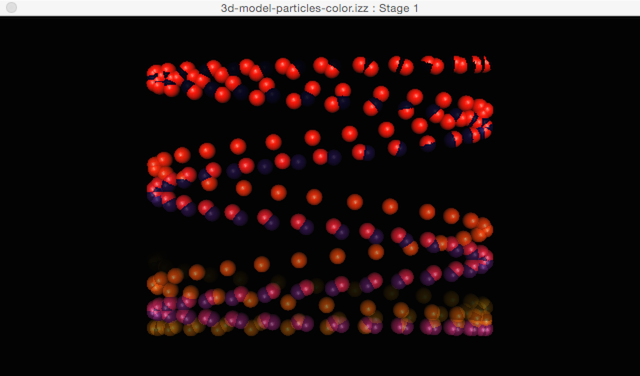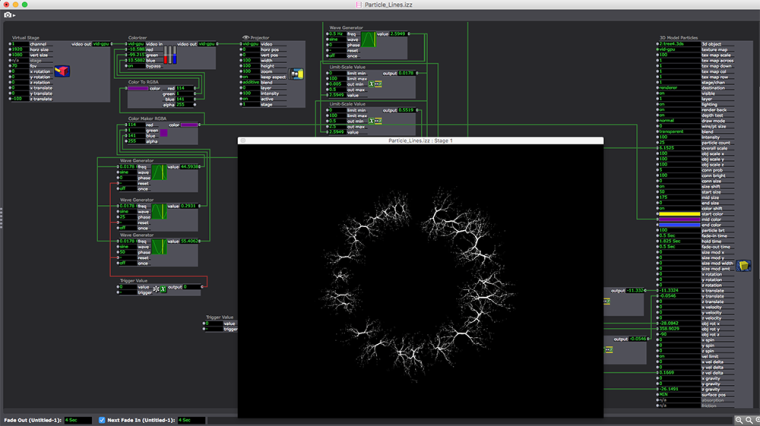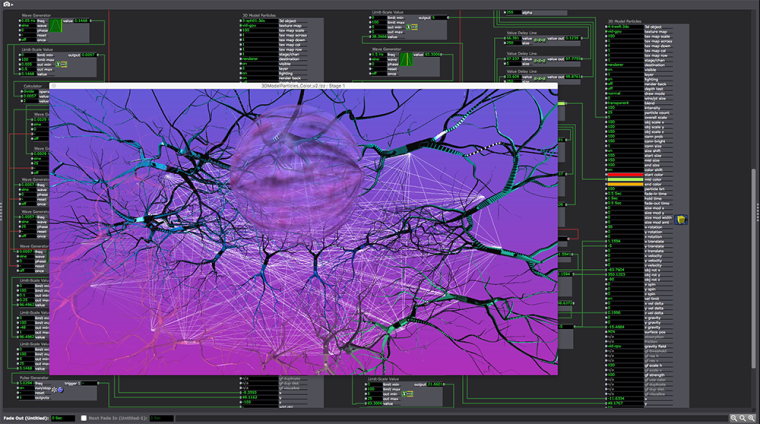[ANSWERED] Change color in 3D Model Particles
-
@mark said:
This is actually a bug
Wow! and We have been working with this actor for a long time - seems like years - with that bug! it is going to make a big difference to what is possible to achieve with that actor - great to see it working again.
cheers
bonemap
-
-
Thank you for your suggestion. I'll try your solution although the issue is actually a bug!
-
-
Thanks for the example. Is it possible to change the color of the connecting lines between particles? They are very beautiful!
Regards,
Wendy -
@chumcw said:
Is it possible to change the color of the connecting lines
Hi,
Another option, that will modulate the color of the lines as well as a the particles, is to use the ‘Virtual Stage’ output going to a ‘Colorizer’ actor input in turn the Colorizer actor output going into a ‘Projector’ (or other actor in your pipeline). With this, the option for 'renderer' needs to be used on the 3D Model Particles input called 'destination', and the 'stage/chan' matching the 'channel' number of the Virtual Stage. If you only want the lines to display without the 3D model, that is also possible by "hiding" the particle - for example reducing the particle 'overall scale' to 0.

Best wishes
Bonemap
-
@bonemap said:
use the ‘Virtual Stage’ output going to a ‘Colorizer’ actor input
This will do, but I wish I can use 'Color Maker' to change the color of the lines because 'Color Maker' makes better color!
Wendy
-
@bonemap said:
only want the lines to display without the 3D model
I did this by not using any 3d object. 'overall scale' is very useful too!

W
-
@chumcw said:
I did this by not using any 3d object
Such a great effect ~ good to see you can achieve what you want!
best wishes
bonemap
-
@chumcw said:
I wish I can use 'Color Maker'
You can do it using the 'color to RGBA' actor - as shown in the screengrab - might give you some ideas?:

best wishes
bonemap
-
-
Hey, I might have made a mistake by saying that there was a confirmed bug.
Is it just the lines between the particles we're talking about? If so, then there's no way to change the color.
Or are we talking about changing the color of the objects themselves?
For some reason I thought that I could not modulate the color an object without a texture map. But I most definitely can.
But here is (essentially) the same patch I posted as an example, and it modulates the color fine.
Huh??????

Let me know what I'm missing.
Thanks,
Mark -
@mark said:
Let me know what I'm missing
After comparing the patch file you posted which demonstrates the color modulation as fully functional, I can say the issue is with the .3DS files I have been using. I have had trouble with Isadora refusing to assign image files as textures created with Blender, the issue is getting Isadora to recognise the texture image files on import. This texture color problem in the actor might be related - so could it be that some compatible 3D files that do not have a texture or surface assigned and appear with simple shading only - do not allow texture modulation in Isadora? So perhaps specific requirements for the 3D files need to be met before they can take advantage of the color shift modulation?
Isadora 2.5.2, MBPr 2015, Sierra 10.12.6
demonstration file attached (note the colorizer actor is in bypass mode)
3D Model Particles color issue

best wishes
bonemap
-
@bonemap said:
so could it be that some compatible 3D files that do not have a texture or surface assigned and appear with simple shading only - do not allow texture modulation in Isadora?
The material assigned to your tree model (tree.3ds) is black. You can't modulate black, because it's already black. Modulation is a multiplication operation, so black doesn't work because everything multiplied by RGB 0,0,0 gives RGB 0,0,0.
Please see the second scene in my updated version of your patch, where I changed the material color to white. Works as expected.
I suppose, regarding the "surface assigned" part of your comment, you are saying that you have some kind of material assigned to the model for modulation to work. That's true. If you don't define some material for the surfaces in the model, then the color is undefined and you can't modulate. (I mean, I guess you could make the assumption that the color is white... but it's not really a big deal to attach a material to an object.)
Also, while it's not free, I have been a big fan of Cheetah 3D. That's the software I use to create all my 3DS files. It's not as sophisticated as Blender, but it's super easy to use and friendly in a way that echoes Isadora's friendliness. (That's the software I used to change the material color just now, and it took about 2.5 seconds.)
Regarding your issue of Isadora recognizing texture images, if you can send me an example file that fails, I can attempt to find out what's going wrong.
Best Wishes,
Mark -
@mark said:
You can't modulate black, because it's already black
Well, that one is my bad! Sometimes, when getting content up for a show a few corners are missed - including going back and cleaning up that 3D file. Thank you for the triage - I have managed to rectify the file in Blender - and am a bit embarrassed to have missed that.
The other issue results in this dialogue box:

The attached .zip file has three 3D files, 01 produced the dialogue, 02 loaded with an image file with a much shorter name, 03 has no texture image, there is also a crash log.
The issue is erratic so it might be an issue with the export from Blender or something equally embarrassing as the first issue.
best wishes
bonemap
-
None of your test files has no texture coordinates. The OBJECT_UV chunk [0x0x4140] is missing from the 3DS file. This is causing a crash in Isadora, which it shouldn't, which I'll need to fix. But the main point is that there is are no texture coordinates to be found in the file.
meshlab also crashed when loading this test01.3ds and test02.3ds. Given that this is a very widely used software, that is not at all a good sign. test03.3ds loaded in meshlab, but no texture was shown.
Cheetah 3D didn't crash for any of the test files, and a material is shown (Material.001). This material it is assigned to the sphere, but no texture information was read.
I don't know what's happening with Blender, but something is not working properly for your 3DS export. A google search of blender 3ds export problem yielded lots of results. You may need to go hunting for an answer.
You should try exporting as an OBJ and using something to convert to 3DS as an experiment.
Best Wishes,
Mark -
Your not alone. I have also found it difficult/frustrating to export these correctly from Blender. An 8.3 file name was one requirement, residing in the same folder as the 3ds file was another.. but also simply the how to steps for Blender are not well documented online.
-
@mark said:
blender 3ds export problem
thank you
At least a problem is narrowed down. I did trawl a bit using a similar search criteria earlier today, but did not discover anything definitive. After going through many options to get a texture positioned on a mesh in Blender today, it just appears very inconsistent, a sequence will work and make it onto the stage in Isadora once but not when attempting to repeat the steps etc. I will have to look into a different 3D software package, I think. Thanks for the suggestion of Cheetah, I have a few colleagues strongly suggesting Form Z and/or Cinema 4D, but I see Cheetah3D has a perpetual license (like Isadora) which is rare these days.
What are the chances of Isadora reading additional 3D file formats? For example it would be wonderful to paint textures on 3D models in Photoshop and import into Isadora using a shared export file format i.e. Collada DAE or Wavefront OBJ from its 3D Menu. Perhaps these file formats require maintenance licenses to consider?
I know, we just keep asking for more and more!
best wishes
bonemap
-
@bonemap said:
What are the chances of Isadora reading additional 3D file formats?
This is on the list for v3. It won't be done for v2.6 as the release date is imminent.
I would probably want to make use of this open source code to allow pretty much any important format. The license is BSD, so it's not a problem to integrate it into Isadora from a licensing point of view. The difficulty is getting it to integrate with Isadora's internal representation, which has some features to allow – for instance – the 3D Model Particles actor to work as it does. That will be some significant work.
Best Wishes,
Mark -
Hi,
All I can say, it is a totally different animal when the external textures are working. I have abandoned Blender to generate 3DS files for Isadora and taken up Mark's advice to use Cheetah3D to combine texture and mesh. Life couldn't get any better right now!

A big shout out to @mark for spending time with this issue, particularly as a new Isadora release iteration is on its way.
Best Wishes,
Bonemap
